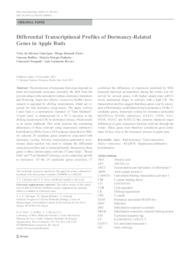Differential transcriptional profiles of dormancy-related genes in apple buds
Differential transcriptional profiles of dormancy-related genes in apple buds
Autoria: FALAVIGNA, V. da S.; PORTO, D. D.; BUFFON, V.; MARGIS-PINHEIRO, M.; PASQUALI, G.; REVERS, L. F.
Resumo: The production of temperate fruit crops depends on plant developmental processes, primarily the shift from the juvenile phase to the reproductive phase, dormancy transitions and flowering. Apple tree (Malus ×domestica Borkh.) development is regulated by chilling temperatures, which are required for bud dormancy progression. The apple cultivar Castel Gala is a spontaneous mutation of "Gala Standard". "Castel Gala" is characterized by a 50 % decrease in the chilling requirement (CR) for dormancy release, which results in an earlier budbreak. This work explores the contrasting phenotypes of these cultivars using suppression subtractive hybridization (SSH). From 1,019 unigenes identified by SSH, we selected 28 candidate genes putatively associated with dormancy cycling. Reverse transcription-quantitative polymerase chain reaction was used to validate the differential expression profiles and to transcriptionally characterize these genes in three distinct apple cultivars ("Castel Gala", "Royal Gala" and "Fuji Standard") during a cycle comprising growth to dormancy. Of the 28 candidate genes analyzed, 17 confirmed the differences in expression predicted by SSH. Seasonal transcript accumulation during the winter was observed for several genes, with higher steady-state mRNA levels maintained longer in cultivars with a high CR. The transcription profiles suggest that these genes may be associated with dormancy establishment and maintenance. Of the 17 candidate genes, transcripts coding for dormancy-associated MADS-box (DAM), dehydrins, GAST1, LTI65, NAC, HTA8, HTA12 and RAP2.12-like proteins displayed major differences in gene expression between cultivars through the winter. These genes were therefore considered good candidates for key roles in the dormancy process in apple trees.
Ano de publicação: 2014
Tipo de publicação: Artigo de periódico
Unidade: Embrapa Uva e Vinho
Palavras-chave: Apple, Castel Gala, Dormencia, Fuji Standard, Genetica vegetal, Maçã, Royal Gala, Temperatura
Observações
1 - Por padrão são exibidas publicações dos últimos 20 anos. Para encontrar publicações mais antigas, configure o filtro ano de publicação, colocando o ano a partir do qual você deseja encontrar publicações. O filtro está na coluna da esquerda na busca acima.
2 - Para ler algumas publicações da Embrapa (apenas as que estão em formato ePub), é necessário ter, no celular ou computador, um desses softwares gratuitos. Sistemas Android: Google Play Livros; IOS: iBooks; Windows e Linux: software Calibre.
Acesse outras publicações
Acesse a Base de Dados da Pesquisa Agropecuária (BDPA) para consultar o acervo completo das bibliotecas da Embrapa.

